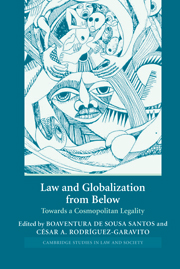Book contents
- Frontmatter
- Contents
- Notes on the contributors
- 1 Law, politics, and the subaltern in counter-hegemonic globalization
- PART ONE LAW AND THE CONSTRUCTION OF A GLOBAL ECONOMY OF SOLIDARITY
- PART TWO TRANSNATIONAL SOCIAL MOVEMENTS AND THE RECONSTRUCTION OF HUMAN RIGHTS
- 8 Limits of law in counter-hegemonic globalization: the Indian Supreme Court and the Narmada Valley struggle
- 9 The Movement of the Landless (MST), juridical field, and legal change in Brazil
- 10 Indigenous rights, transnational activism, and legal mobilization: the struggle of the U'wa people in Colombia
- 11 Defensive and oppositional counter-hegemonic uses of international law: from the International Criminal Court to the common heritage of humankind
- PART THREE LAW AND PARTICIPATORY DEMOCRACY: BETWEEN THE LOCAL AND THE GLOBAL
- Index
- References
8 - Limits of law in counter-hegemonic globalization: the Indian Supreme Court and the Narmada Valley struggle
Published online by Cambridge University Press: 07 July 2009
- Frontmatter
- Contents
- Notes on the contributors
- 1 Law, politics, and the subaltern in counter-hegemonic globalization
- PART ONE LAW AND THE CONSTRUCTION OF A GLOBAL ECONOMY OF SOLIDARITY
- PART TWO TRANSNATIONAL SOCIAL MOVEMENTS AND THE RECONSTRUCTION OF HUMAN RIGHTS
- 8 Limits of law in counter-hegemonic globalization: the Indian Supreme Court and the Narmada Valley struggle
- 9 The Movement of the Landless (MST), juridical field, and legal change in Brazil
- 10 Indigenous rights, transnational activism, and legal mobilization: the struggle of the U'wa people in Colombia
- 11 Defensive and oppositional counter-hegemonic uses of international law: from the International Criminal Court to the common heritage of humankind
- PART THREE LAW AND PARTICIPATORY DEMOCRACY: BETWEEN THE LOCAL AND THE GLOBAL
- Index
- References
Summary
INTRODUCTION
Popular struggles have an ambivalent relationship with the law. At one level, they tend to see law as a force for status quo and domination, which must either be contested as part of a larger political struggle or largely ignored as irrelevant. Yet, they can hardly avoid the law as it also provides them space for resistance. Indeed, there is an increasing sensibility that law is a terrain of contestation between different actors including social movements and states, and that a theory of law or adjudication that ignores this fact is inadequate. There are several reasons why this is so under conditions of globalization. First, law operates at multiple scales under globalization, that is, simultaneously at the international, national, and local levels. As such, it provides much greater opportunity to use law as a tool of contestation by social movements who can deploy legal tools at one level against another (Klug 2000; Santos 2002). Secondly, the forces that social movements are up against in their counter-hegemonic struggles are often a combination of local and global elites, and that in turn defines the space for a politics of resistance that is neither purely local nor global (Klug 2000:50–51; see also Esteva and Prakash 1998). This is particularly so in the case of contestations over development (Khagram, Riker, and Sikkink 2002) and especially over large dams (World Commission on Dams 2000).
- Type
- Chapter
- Information
- Law and Globalization from BelowTowards a Cosmopolitan Legality, pp. 183 - 217Publisher: Cambridge University PressPrint publication year: 2005
References
- 14
- Cited by

